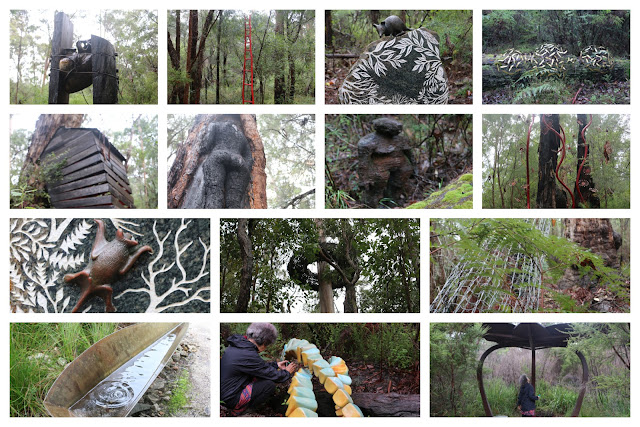After a leisurely breakfast at Sid's, we headed into the Information Centre at Northcliffe. Met a very informative lady who filled us in on the local area including the Understory Sculpture Walk. Quite a story there: The Sculpture Walk is a community initiated and run project, its creation driven by the zeal of resident Fiona Sinclair and a team of locals who raised substantial funds and commissioned visual artists, writers and musicians to use their chosen media to respond to the forest. As it was raining the kind lady loaned us umbrellas for the 1.2 km wander along a path through a pristine forest of Karri, Jarrah, and Marri trees. Quote “The problem with art placed in a forest is that the forest is so perfect already that the art can easily feel presumptuous, superfluous, definitely imposed, and in some cases even invasive. One way to overcome this burden is to make artworks that really belong in the forest and are of the forest. Another is to construct something functional like a seat or a shelter, upon which one can rest pondering the greenness and meditating on the sound of birds and crickets.”
They did it well at Northcliffe
Next stop for the day was the Dave Evans Bicentennial Tree. The tree, at 65m, is the tallest of three fire lookout trees that are open to the public in the Pemberton area. It was pegged in 1988 as part of Australia’s bicentennial celebrations.
Climbing this tree is not for the faint-hearted. However, those who do venture up the 165 pegs to the top will be rewarded with 360-degree views of the karri forest and glimpses of the Yeagarup Dunes and coast beyond. Alex climbed part of (to the first platform) but that was far enough as it was still raining, steps were slippery and it was quite windy.
We drove on to the Cascades and had a pleasant walk along a bubbling, Lefroy Brook.
The Lefroy Brook is home to a population of pouched lampreys (Geotria australis). These eel like creatures sound like something from a horror movie – they attack their prey with suction mouth and a tongue like a round chainsaw. Luckily lampreys are harmless to humans and leave their vicious dietary habits behind in the ocean when they migrate from the sea into the rivers to breed. During winter, hundreds of lampreys enter the Lefroy Brook and swim upstream to breed. They can be seen congregated at obstacles such as weirs or rapids as they use their sucking mouthparts to scale the slippery rocks. About a year later, the young lampreys migrate downstream and out to the ocean. None to be seen today.
At Pemberton, we tried to find somewhere for lunch after visiting the Information Centre and Museum – quite an interesting spot. We couldn't find anywhere open. It was 3 o'clock at this stage and it was Sunday. We ended up setting ourselves up in a carpark, put out the awning and kitchen and had soup and toast.
After lunch, it was a quick stop at the Diamond Tree. In 1939, the search was on to find a suitable karri tree south of Manjimup to be used as a fire lookout tree. This tree, which became known as the Diamond Tree, was pegged in 1940 and a cabin built at the top.
Camp tonight was at Greenbushes where we set up at the Sporting Complex.
It was from this cabin that the tower person scanned the surrounding landscape looking for signs of smoke. Early detection of bushfires made them much easier to control. The Diamond Tree is open as a tourist attraction and brave visitors can climb the 49 metres to the lookout cabin.
Camp tonight was at Greenbushes where we set up at the Sporting Complex.












